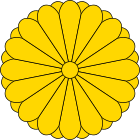- Sadaijin
-
Pre-modern Japan 
This article is part of the series:
Daijō-kan
Council of State- Chancellor or Chief Minister (Daijō-daijin)
- Minister of the Left (Sadaijin)
- Minister of the Right (Udaijin)
- Minister of the Center (Naidaijin)
- Major Counselor (Dainagon)
- Middle Counselor (Chūnagon)
- Minor Counselor (Shōnagon)
- Ministry of the Center (Nakatsukasa-shō)
- Ministry of Civil Services (Shikibu-shō)
- Ministry of Ceremonies (Jibu-shō)
- Ministry of Taxation (Minbu-shō)
- Ministry of the Military (Hyōbu-shō)
- Ministry of Justice (Gyōbu-shō)
- Ministry of the Treasury (Ōkura-shō)
- Ministry of the Imperial Household (Kunai-shō)
_____________________
Meiji government
_____________________
Postwar Shōwa period
- Imperial Household Agency (Kunaichō)
Sadaijin (左大臣), most commonly translated as "Minister of the Left", was a government position in Japan in the late Nara and Heian periods. The position was consolidated in the Taihō Code of 702. The Asuka Kiyomihara Code of 689 marks the initial appearance of the Sadaijin in the context of a central administrative body called the Daijō-kan (Council of State). This early Daijō-kan was composed of the three ministers—the Daijō-daijin (Chancellor), the Sadaijin and the Udaijin (Minister of the Right).[1]
The sadaijin was the Senior Minister of State, overseeing all functions of government with the Udaijin as his deputy.
Within the Daijō-kan, the sadaijin was second only to the Daijō Daijin (the Great Minister, or Chancellor of the Realm) in power and influence. Frequently, a member of the Fujiwara family would take the position in order to help justify and exercise the power and influence the family held.
The post of sadaijin, along with the rest of the Daijō-kan structure, gradually lost power over the 10th and 11th centuries, as the Fujiwara came to dominate politics more and more. The system was essentially powerless by the end of the 12th century, when the Minamoto, a warrior clan, seized control of the country from the court aristocracy (kuge). However, it is not entirely clear when the Daijō-kan system was formally dismantled prior to the Meiji era.
Notes
- ^ Hall, John Whitney et al. (1993). The Cambridge History of Japan, p. 232.
References
- (Japanese) Asai, T. (1985). Nyokan Tūkai. Tokyo: Kōdansha.
- Dickenson, Walter G. (1869). Japan: Being a Sketch of the History, Government and Officers of the Empire. London: W. Blackwood and Sons. OCLC 10716445
- Hall, John Whitney, Delmer M. Brown and Kozo Yamamura. (1993). The Cambridge History of Japan. Cambridge: Cambridge University Press. 10-ISBN 0-521-22352-0; 13-ISBN 978-0-5212-2352-2
- Ozaki, Yukio. (2001). The Autobiography of Ozaki Yukio: The Struggle for Constitutional Government in Japan. [Translated by Fujiko Hara]. Princeton: Princeton University Press. 10-ISBN 0-691-05095-3 (cloth)
- (Japanese) Ozaki, Yukio. (1955). Ozak Gakudō Zenshū. Tokyo: Kōronsha.
- Sansom, George (1958). A History of Japan to 1334. Stanford: Stanford University Press.
- Screech, Timon. (2006). Secret Memoirs of the Shoguns: Isaac Titsingh and Japan, 1779–1822. London: RoutledgeCurzon. ISBN 0-700-71720-X
- (French) Titsingh, Isaac. (1834). [Siyun-sai Rin-siyo/Hayashi Gahō, 1652], Nipon o daï itsi ran; ou, Annales des empereurs du Japon. Paris: Oriental Translation Fund of Great Britain and Ireland.
- Varley, H. Paul, ed. (1980). [ Kitabatake Chikafusa, 1359], Jinnō Shōtōki ("A Chronicle of Gods and Sovereigns: Jinnō Shōtōki of Kitabatake Chikafusa" translated by H. Paul Varley). New York: Columbia University Press. ISBN 0-231-04940-4
Categories:- Government of feudal Japan
- Japanese historical terms
- Meiji Restoration
- Government of Japan
- Government ministers of Japan
Wikimedia Foundation. 2010.
